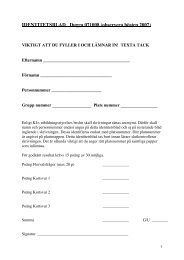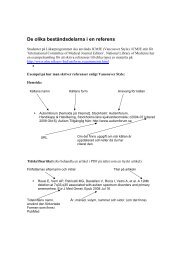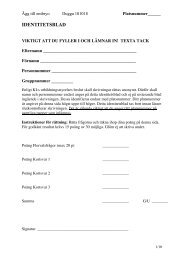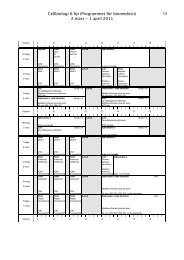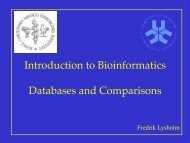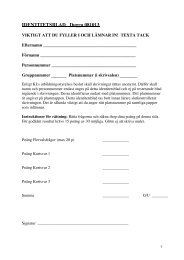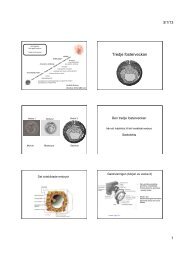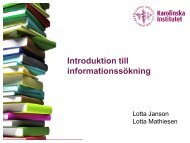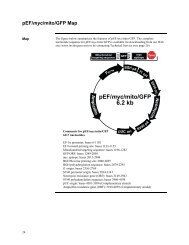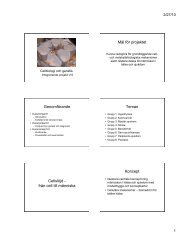Sergey Belikov - CMB Education
Sergey Belikov - CMB Education
Sergey Belikov - CMB Education
You also want an ePaper? Increase the reach of your titles
YUMPU automatically turns print PDFs into web optimized ePapers that Google loves.
Den Friska Människan<br />
UTVECKLING: Från ägg till embryo<br />
Why are we doing this?<br />
Vetenskapligt projekt<br />
<strong>Sergey</strong> <strong>Belikov</strong><br />
sergey.belikov@ki.se<br />
Understanding how medical research works<br />
Understanding significance of medical research<br />
Learning to communicate about news in science<br />
How you will achieve this?<br />
-via learning how to search the scientific literature<br />
-via learning how to read scientific paper<br />
The outcome is a short paper (report)<br />
Goals:<br />
Scientific project – part of VetU<br />
-for genetic diseases, to be able to discuss the<br />
relationship between heredity and/or environment on<br />
the one hand and phenotype on the other,<br />
-to collect and analyze basic scientific and clinical<br />
aspects of the disease and to summarize results in<br />
writing,<br />
-this manuscript should answer the question: "What do<br />
we know about the genetic links to disease and how we<br />
know that?" In addition, the paper may contain a brief<br />
reflection on the importance of the research<br />
discussed.<br />
Intellectual Disability (ID)… characterized by<br />
significant limitations both in intellectual functioning<br />
(reasoning, learning, problem solving; IQ
What are you writing?<br />
Commentary<br />
Comment<br />
News and Views<br />
Preview<br />
Comment(ary) or News and Views or Preview highlights<br />
one or several research papers published (usually) in<br />
the same issue of the journal or in a recent issue of<br />
another journal, placing the results in the context of<br />
ongoing research in the field for broad readership.<br />
Formal Constrains or Instruction for Authors<br />
-The manuscript should be 2 A4 max including references,<br />
in English or Swedish. No cover letter.<br />
-The manuscript should be written at a level which makes<br />
it understandable for your course mates.<br />
-The manuscript should be formatted (font, size, line<br />
spacing) so that it is readable, well structured and<br />
presented in the form easy for reading.<br />
-Headings should be written in bold.<br />
-Page numbering on each page.<br />
Formal Constrains or Instruction for Authors<br />
Your paper falls into two parts:<br />
-The first part of the manuscript is a general<br />
introduction to the subject based on literature search in<br />
the library (one third to half of the paper).<br />
-The second part of the manuscript presents the short<br />
description of the article (one third to half of the paper).<br />
Example of such a description could be found in<br />
Läkartidningen ( Rubrik “Nya Rön”)<br />
This is just an example from Läkartidningen<br />
See link at: http://education.cmb.ki.se<br />
Formal Constrains or Instruction for Authors<br />
-The printed version should start with the title of the<br />
paper, author's name in italics, personal number and<br />
e-mail address (KI). The title should be less than 100<br />
characters and should reflect the content of the paper.<br />
Your paper should have an abstract. It summarizes, in one<br />
paragraph (max 350 characters), the major aspects of<br />
the entire paper.<br />
-The manuscript must contain a Figure, about 4-6 cm wide,<br />
with a Figure legend. Refer to the Figure in the text; the<br />
original source should be acknowledged<br />
Example: Reproduced from (Ref).<br />
100<br />
80<br />
Humans created by<br />
supernatural entity<br />
60<br />
%<br />
believing<br />
40<br />
Human evolved from<br />
20<br />
nonhuman ancestors<br />
No opinion<br />
0<br />
1980 1985 1990 1995 2000 2005<br />
Year of survey (Gallup poll)<br />
Fig. 1. Americans’ disbelief in evolution is<br />
stable over time. Reproduced from<br />
http://www.swarthmore.edu.<br />
EXAMPLE<br />
Figure legend<br />
http://www.swarthmore.edu/NatSci/cpurrin1/posteradvice.htm<br />
2/6/12<br />
2
You must ask for permission to use copyright protected<br />
material such as, for example, figure in the article!<br />
It is very easy to get a permission!<br />
Usually done electronically, via journal web-site. Do not<br />
forget to state that the copyright protected material will<br />
be used in an academic/educational context.<br />
Formal Constrains or Instruction for Authors<br />
-The manuscript must contain a table with at least two<br />
rows and two columns, in which key MeSH terms linked to<br />
the disease, are explained in a popular way for the reader.<br />
-A table should be given a brief title/legend.<br />
-A table should be referred to in the text<br />
-Explanatory matters are placed in footnotes of the Table.<br />
Formal Constrains or Instruction for Authors<br />
-A short reference list (min. five references, at least three<br />
original articles) should be given at the end of the paper. All<br />
references must be given according to ICMJE standard<br />
(Vancouver Style).<br />
-The text must include references to the sources.<br />
The rule: all statements above common sense should have a<br />
reference.<br />
Remember that reference is valid most often only for one<br />
sentence!<br />
Permissions & Reprints<br />
EXAMPLE<br />
Table legend/title<br />
Column titles<br />
Data<br />
Footnotes<br />
Adapted from The American Journal of Human Genetics 89, 176–182, 2011<br />
For example: Prostate cancer is the most common type of cancer<br />
in men in the US, where it is responsible for more male deaths<br />
than any other cancer, except lung cancer (Ref 1). The specific<br />
causes of prostate cancer remain unknown (Ref 2). Prostate cancer<br />
risk factors include age, genetics, race, lifestyle/diet (Ref 3). The<br />
average age at the time of diagnosis is 70 years (Ref 4).<br />
If Ref1 = Ref2 = Ref3 = Ref4<br />
For example: Prostate cancer is the most common type of cancer<br />
in men in the US, where it is responsible for more male deaths<br />
than any other cancer, except lung cancer. The specific causes of<br />
prostate cancer remain unknown. Prostate cancer risk factors<br />
include age, genetics, race, lifestyle/diet. The average age at the<br />
time of diagnosis is 70 years (Reviewed in (Ref)).<br />
2/6/12<br />
3
Avoid direct plagiarism and indirect plagiarism<br />
• Do not use the exact wording from another author in<br />
your manuscript<br />
• Use quotation marks if you borrow blocks of the text.<br />
Cut & paste<br />
Specifikationer för uppsatsen Guide_for_students-VetU.pdf<br />
Some hints<br />
90% (or more!) of writing process is thinking!<br />
Avoid repetitions! Make your mind where particular statements<br />
should be placed and do not repeat them.<br />
The crucial part of writing is revision. Scientific writing<br />
requires self-criticism.<br />
There are many ways to express the message you want to<br />
deliver. In almost all cases the shortest alternative is the best.<br />
You’ve downloaded and printed the paper…<br />
Journal articles are an integral form of scientific<br />
discourse and the most common form of scientific<br />
communication.<br />
What to do and how to perform?<br />
New words/terms can be looked up on the internet<br />
(Pubmed, MedlinePlus, MedcineNet), or in “Alberts”<br />
textbook (glossary). In this project you should focus on<br />
genetics not to get caught up in details.<br />
-Manuscript writing can begin during or immediately<br />
after the literature search.<br />
-There is time in the afternoon, otherwise write it in<br />
your own pace.<br />
-A moderate level of ambition works well in this project.<br />
What to do and how to perform?<br />
1. Participate in the Introduction lecture<br />
2. Participate in lecture on Information searches<br />
3. Download and print the paper<br />
4. Start reading the paper.<br />
5. Participate in the Clinical lectures<br />
6. Participate in Information searches at the library<br />
7. Participate in Word-help session (must register)<br />
8. Participate in Discussion 1 (to discuss article with teachers)<br />
9. Write Paper; deadline February 27<br />
10. Submit paper at MBB (see instructions at course wiki)<br />
11. Papers will be marked for individual feedback before<br />
the end of course moment. (Form at course WiKi)<br />
12. Group feedback concerning papers, and references (KIB)<br />
Title<br />
A certain format was established for scientific papers.<br />
Usually paper is divided into several sections…<br />
Abstract<br />
Introduction<br />
Materials and Methods (Methods; Subjects and Methods)<br />
Results<br />
Discussion<br />
References<br />
Conclusions<br />
Asknowledgments<br />
Supplements<br />
Results and Discussion + Figures and Tables<br />
2/6/12<br />
4
REPORT<br />
However, in some journals, there are no<br />
division on discrete sections, except for an<br />
abstract and a reference list…<br />
Mutations in the Alpha 1,2-Mannosidase Gene,<br />
MAN1B1, Cause Autosomal-Recessive Intellectual Disability<br />
Muhammad Arshad Rafiq, 1,14 Andreas W. Kuss, 2,14,15 Lucia Puettmann, 2 Abdul Noor, 1<br />
Annapoorani Ramiah, 3 Ghazanfar Ali, 4,5 Hao Hu, 2 Nadir Ali Kerio, 4 Yong Xiang, 3 Masoud Garshasbi, 2<br />
Muzammil Ahmad Khan, 1,4 Gisele E. Ishak, 6 Rosanna Weksberg, 7 Reinhard Ullmann, 2<br />
Andreas Tzschach, 2 Kimia Kahrizi, 8 Khalid Mahmood, 9 Farooq Naeem, 10 Muhammad Ayub, 11,12<br />
Kelley W. Moremen, 3 John B. Vincent, 1,13,* Hans Hilger Ropers,2,14 Muhammad Ansar, 3<br />
and Hossein Najmabadi 8<br />
We have used genome-wide genotyping to identify an overlapping homozygosity-by-descent locus on chromosome 9q34.3 (MRT15) in<br />
four consanguineous families affected by nonsyndromic autosomal-recessive intellectual disability (NS-ARID) and one in which the<br />
patients show additional clinical features. Four of the families are from Pakistan, and one is from Iran. Using a combination of nextgeneration<br />
sequencing and Sanger sequencing, we have identified mutations in the gene MAN1B1, encoding a mannosyl oligosaccharide,<br />
alpha 1,2-mannosidase. In one Pakistani family, MR43, a homozygous nonsense mutation (RefSeq number NM_016219.3:<br />
c.1418G>A [p.Trp473*]), segregated with intellectual disability and additional dysmorphic features. We also identified the missense<br />
mutation c. 1189G>A (p.Glu397Lys; RefSeq number NM_016219.3), which segregates with NS-ARID in three families who come<br />
from the same village and probably have shared inheritance. In the Iranian family, the missense mutation c.1000C>T (p.Arg334Cys;<br />
RefSeq number NM_016219.3) also segregates with NS-ARID. Both missense mutations are at amino acid residues that are conserved<br />
across the animal kingdom, and they either reduce k cat by ~1300-fold or disrupt stable protein expression in mammalian cells.<br />
MAN1B1 is one of the few NS-ARID genes with an elevated mutation frequency in patients with NS-ARID from different populations.<br />
Intellectual disability (ID), also called mental retardation<br />
(MR), is a devastating neurodevelopmental disorder that<br />
has a serious impact on the affected individuals and their<br />
families, as well as on health and social services. It is<br />
believed to occur with a prevalence of ~1%–3% within<br />
the population, 1,2 and is frequently the result of genetic<br />
aberrations. ID can present as the sole clinical feature (nonsyndromic<br />
[NS]; see MIM 249500), or it can be present<br />
with additional clinical or dysmorphological features (syndromic<br />
[S]). Generally speaking, it is much more straightforward<br />
to identify the genetic cause of S-ID patients<br />
because the comorbid features frequently enable a medical<br />
geneticist to narrow down the suspected cause to a<br />
mutation in a short list of genes, or perhaps in a single<br />
gene. However, for individuals with NS-ID, no secondary<br />
clues assist the molecular diagnosis. ID is significantly<br />
more frequent in males than in females, and it had been<br />
assumed that ~25% of severe cases were X-linked; however,<br />
a recent review suggests that X-linked mutations<br />
contribute to no more than 10% of cases, 3 whose mutations cause NS-ID, both dominant and recessive.<br />
However, as a result of the high degree of genetic<br />
heterogeneity, mutations in only seven genes have been<br />
reported to cause NS-ARID, and all of these have been<br />
identified on the basis of mapping regions of autozygosity<br />
or homozygosity-by-descent (HBD) in multiplex consanguineous<br />
families (reviewed in Kaufman et al.<br />
and thus it is<br />
expected that there will be many more autosomal genes<br />
4 ).<br />
We ascertained three large NS-ARID-affected multiplex<br />
consanguineous families from a farming community in<br />
the Dera Ghazi Khan district, within Punjab province in<br />
Pakistan (MR7, MR8, MR9), one from Sukkur in Sindh<br />
province (MR43), and one from Iran (8600060; Figure 1).<br />
Appropriate informed consent was obtained for all participants<br />
in the study, and institutional research ethics<br />
approval was obtained.<br />
The description of ascertainment, clinical features, and<br />
mapping for families MR7, MR8, and MR9 are given<br />
elsewhere 5 but are summarized in Tables 1 and 2. Two<br />
individuals from MR7 (IV:5 and IV:6, age 14 and 13 years,<br />
respectively) were assessed and found to have similar<br />
developmental history. Both had delayed developmental<br />
1 Molecular Neuropsychiatry and Development Lab, Neurogenetics Section, Centre for Addiction and Mental Health, Toronto, Ontario M5T 1R8, Canada;<br />
2 Max Planck Institute for Molecular Genetics, Berlin D-14195, Germany; 3 Complex Carbohydrate Research Center, University of Georgia, Athens, GA<br />
30602, USA; 4 Department of Biochemistry, Quaid-I-Azam University, Islamabad, Pakistan; 5 Center of Excellence in Biotechnology Research, King Saud<br />
University, Riyadh 11451, Kingdom of Saudi Arabia; 6 Department of Radiology, Seattle Children’s Hospital, University of Washington, Seattle, WA<br />
98105, USA; 7 Program for Genetic and Genomic Biology, Hospital for Sick Children, Toronto, Ontario M5G1L7, Canada; 8 Genetics Research Center,<br />
University of Social Welfare and Rehabilitation Sciences, Tehran 1985713834, Iran; 9 Arrahma Hospital for Mental Health, Multan 60000, Pakistan; 10 Lahore<br />
Institute of Research & Development, Lahore 54000, Pakistan; 11 Tees, Esk, and Wear Valleys National Health Service Foundation Trust, Durham DL2 2TS,<br />
UK; 12 School for Health and Medicine, University of Durham, Durham TS17 6BH, UK; 13 Department of Psychiatry, University of Toronto, Toronto, Ontario<br />
M5T 1R8, Canada<br />
14 These authors contributed equally<br />
15 Present address: Institute for Human Genetics, Interfaculty Institute for Genetics and Functional Genomics, Ernst Moritz Arndt University of Greifswald,<br />
Greifswald D-17475, Germany<br />
*Correspondence: john_vincent@camh.net<br />
DOI 10.1016/j.ajhg.2011.06.006. Ó2011 by The American Society of Human Genetics. All rights reserved.<br />
176 The American Journal of Human Genetics 89, 176–182, July 15, 2011<br />
References<br />
Methods: describes what<br />
was done to answer the<br />
research question. How the<br />
problem was studied?<br />
In this paper embedded in<br />
the main text<br />
Supplemental<br />
data<br />
Results: what<br />
were the findings?<br />
REPORT<br />
Mutations in the Alpha 1,2-Mannosidase Gene,<br />
MAN1B1, Cause Autosomal-Recessive Intellectual Disability<br />
Muhammad Arshad Rafiq, 1,14 Andreas W. Kuss, 2,14,15 Lucia Puettmann, 2 Abdul Noor, 1<br />
Annapoorani Ramiah, 3 Ghazanfar Ali, 4,5 Hao Hu, 2 Nadir Ali Kerio, 4 Yong Xiang, 3 Masoud Garshasbi, 2<br />
Muzammil Ahmad Khan, 1,4 Gisele E. Ishak, 6 Rosanna Weksberg, 7 Reinhard Ullmann, 2<br />
Andreas Tzschach, 2 Kimia Kahrizi, 8 Khalid Mahmood, 9 Farooq Naeem, 10 Muhammad Ayub, 11,12<br />
Kelley W. Moremen, 3 John B. Vincent, 1,13,* Hans Hilger Ropers,2,14 Muhammad Ansar, 3<br />
and Hossein Najmabadi 8<br />
We have used genome-wide genotyping to identify an overlapping homozygosity-by-descent locus on chromosome 9q34.3 (MRT15) in<br />
four consanguineous families affected by nonsyndromic autosomal-recessive intellectual disability (NS-ARID) and one in which the<br />
patients show additional clinical features. Four of the families are from Pakistan, and one is from Iran. Using a combination of nextgeneration<br />
sequencing and Sanger sequencing, we have identified mutations in the gene MAN1B1, encoding a mannosyl oligosaccharide,<br />
alpha 1,2-mannosidase. In one Pakistani family, MR43, a homozygous nonsense mutation (RefSeq number NM_016219.3:<br />
c.1418G>A [p.Trp473*]), segregated with intellectual disability and additional dysmorphic features. We also identified the missense<br />
mutation c. 1189G>A (p.Glu397Lys; RefSeq number NM_016219.3), which segregates with NS-ARID in three families who come<br />
from the same village and probably have shared inheritance. In the Iranian family, the missense mutation c.1000C>T (p.Arg334Cys;<br />
RefSeq number NM_016219.3) also segregates with NS-ARID. Both missense mutations are at amino acid residues that are conserved<br />
across the animal kingdom, and they either reduce k cat by ~1300-fold or disrupt stable protein expression in mammalian cells.<br />
MAN1B1 is one of the few NS-ARID genes with an elevated mutation frequency in patients with NS-ARID from different populations.<br />
Intellectual disability (ID), also called mental retardation<br />
(MR), is a devastating neurodevelopmental disorder that<br />
has a serious impact on the affected individuals and their<br />
families, as well as on health and social services. It is<br />
believed to occur with a prevalence of ~1%–3% within<br />
the population, 1,2 and is frequently the result of genetic<br />
aberrations. ID can present as the sole clinical feature (nonsyndromic<br />
[NS]; see MIM 249500), or it can be present<br />
with additional clinical or dysmorphological features (syndromic<br />
[S]). Generally speaking, it is much more straightforward<br />
to identify the genetic cause of S-ID patients<br />
because the comorbid features frequently enable a medical<br />
geneticist to narrow down the suspected cause to a<br />
mutation in a short list of genes, or perhaps in a single<br />
gene. However, for individuals with NS-ID, no secondary<br />
clues assist the molecular diagnosis. ID is significantly<br />
more frequent in males than in females, and it had been<br />
assumed that ~25% of severe cases were X-linked; however,<br />
a recent review suggests that X-linked mutations<br />
contribute to no more than 10% of cases, 3 and thus it is<br />
expected that there will be many more autosomal genes<br />
whose mutations cause NS-ID, both dominant and recessive.<br />
However, as a result of the high degree of genetic<br />
heterogeneity, mutations in only seven genes have been<br />
reported to cause NS-ARID, and all of these have been<br />
identified on the basis of mapping regions of autozygosity<br />
or homozygosity-by-descent (HBD) in multiplex consanguineous<br />
families (reviewed in Kaufman et al. 4 ).<br />
We ascertained three large NS-ARID-affected multiplex<br />
consanguineous families from a farming community in<br />
the Dera Ghazi Khan district, within Punjab province in<br />
Pakistan (MR7, MR8, MR9), one from Sukkur in Sindh<br />
province (MR43), and one from Iran (8600060; Figure 1).<br />
Appropriate informed consent was obtained for all participants<br />
in the study, and institutional research ethics<br />
approval was obtained.<br />
The description of ascertainment, clinical features, and<br />
mapping for families MR7, MR8, and MR9 are given<br />
elsewhere 5 but are summarized in Tables 1 and 2. Two<br />
individuals from MR7 (IV:5 and IV:6, age 14 and 13 years,<br />
respectively) were assessed and found to have similar<br />
developmental history. Both had delayed developmental<br />
1 Molecular Neuropsychiatry and Development Lab, Neurogenetics Section, Centre for Addiction and Mental Health, Toronto, Ontario M5T 1R8, Canada;<br />
2 Max Planck Institute for Molecular Genetics, Berlin D-14195, Germany; 3 Complex Carbohydrate Research Center, University of Georgia, Athens, GA<br />
30602, USA; 4 Department of Biochemistry, Quaid-I-Azam University, Islamabad, Pakistan; 5 Center of Excellence in Biotechnology Research, King Saud<br />
University, Riyadh 11451, Kingdom of Saudi Arabia; 6 Department of Radiology, Seattle Children’s Hospital, University of Washington, Seattle, WA<br />
98105, USA; 7 Program for Genetic and Genomic Biology, Hospital for Sick Children, Toronto, Ontario M5G1L7, Canada; 8 Genetics Research Center,<br />
University of Social Welfare and Rehabilitation Sciences, Tehran 1985713834, Iran; 9 Arrahma Hospital for Mental Health, Multan 60000, Pakistan; 10 Lahore<br />
Institute of Research & Development, Lahore 54000, Pakistan; 11 Tees, Esk, and Wear Valleys National Health Service Foundation Trust, Durham DL2 2TS,<br />
UK; 12 School for Health and Medicine, University of Durham, Durham TS17 6BH, UK; 13 Department of Psychiatry, University of Toronto, Toronto, Ontario<br />
M5T 1R8, Canada<br />
14 These authors contributed equally<br />
15 Present address: Institute for Human Genetics, Interfaculty Institute for Genetics and Functional Genomics, Ernst Moritz Arndt University of Greifswald,<br />
Greifswald D-17475, Germany<br />
*Correspondence: john_vincent@camh.net<br />
DOI 10.1016/j.ajhg.2011.06.006. Ó2011 by The American Society of Human Genetics. All rights reserved.<br />
176 The American Journal of Human Genetics 89, 176–182, July 15, 2011<br />
Title is the first thing a reader looks at!<br />
Accurately, completely, and specifically<br />
identify the main topic<br />
-State the principal objectives of the study<br />
-Describe the methods employed<br />
-Summarize the results<br />
-State the principal conclusion<br />
Introduction: mini review on the subject.<br />
Includes previous findings and the nature<br />
of the problem.<br />
Results<br />
prominent nose. However, because photographs of other sequences that are known to have similar enzymatic func-<br />
family members were not available, these cannot be tions but in different cellular contexts (Figure 3). The<br />
excluded as familial traits, and the family is categorized c.1189G>A substitution creates a StyI restriction endonu-<br />
as nonsyndromic (see Tables 1 and 2).<br />
clease cutting site, and the c.1418G>A destroys a BamHI<br />
When all the Pakistani and Iranian families are taken restriction site. We used PCR followed by either StyI or<br />
into consideration, a combined critical region spanning BamH1 digestion to screen a cohort of 252 Pakistani<br />
nucleotides 137,667,734–139,653,199 (~2.0 Mb) was likely controls, but the mutant alleles were not detected. None<br />
to harbor a gene in which mutations lead to NS-ARID (see of the three MAN1B1 substitutions have been reported in<br />
Figure 2). This critical region contains 82 RefSeq coding any SNP databases to date and were not present in the<br />
genes (UCSC hg18 March 2006).<br />
1000 Genomes Version 60.37e.<br />
For the Iranian family, we performed next-generation MAN1B1 encodes the protein endoplasmic reticulum<br />
sequencing by enrichment of the exonic regions within mannosyl-oligosaccharide 1,2-alpha-mannosidase (ERManI;<br />
the linkage interval by using a custom Agilent SureSelect EC ¼ 3.2.1.113). ERManI and other class 1 a-mannosidases<br />
array, followed by sequencing with the Illumina Genome are members of the glycosyl hydrolase family 47 (GH47),<br />
Analyzer II platform. Analysis of prospective changes from are believed to be key enzymes involved in the maturation<br />
the critical region indicated DNA variants in just three of N-glycans in the secretory pathway,<br />
genes: GPSM1 [MIM 609491] (one base pair deleted at<br />
Chr9:139,235,486 (hg19); RefSeq number NM_015597.4;<br />
c.1243 delA [p. Thr415Glnfs*55]), SOHLH1 [MIM 610224]<br />
(missense change: c. 916C>A [p.Leu306Met]; RefSeq<br />
number NM_001101677.1) and MAN1B1 [MIM 604346]<br />
(missense change: c.1000C>T [p.Arg334Cys]; RefSeq<br />
number NM_016219.3). However, only the MAN1B1 change<br />
segregated in pedigree 8600060. This change, which occurs<br />
in exon 7, was not present in 155 Iranians or 191 Germans.<br />
For the Pakistani families, a number of genes were<br />
selected as candidates for sequencing, but sequence analysis<br />
excluded INPP5E [MIM 613037], GRIN1 [MIM<br />
138249], ABCA2 [MIM 600047], CACN1AB, EHTM1,<br />
KCNT1 [MIM 608167], CAMSAP1, OLFM1 [MIM 605336],<br />
GLT6D1 [MIM 613699], SEC16A [MIM 612854], LHX3<br />
[MIM 600577], ANAPC2 [MIM 606946], PNPLA7 [MIM<br />
612122), and TUBB2C [MIM 602660]. Sequence analysis<br />
of GPSM1, SOHLH1, and MAN1B1 was then undertaken.<br />
The same 1 bp deletion was observed in GPSM1 in an<br />
affected member of MR43, however this did not segregate,<br />
and it was present in homozygous form in an unaffected<br />
sibling. This deletion occurs within the last exon of<br />
GPSM1, but the location is only present within the coding<br />
region for one of the four known isoforms of the gene<br />
(RefSeq; UCSC Hg18, March 2006) and is either within<br />
intron 9 or upstream for the other isoforms. No changes<br />
were found in SOHLH1, but a missense mutation in exon<br />
8 and a nonsense mutation in exon 9 were found in<br />
MAN1B1 for MR7, MR8, MR9 (NM_016219.3: c. 1189G>A<br />
[p.Glu397Lys]), and MR43 (NM_016219.3: c.1418G>A<br />
[p.Trp473*]), respectively.<br />
Both the Arg334 and Glu397 residues are conserved<br />
across evolution of the animal kingdom (Figure 1). Furthermore,<br />
these residues are also conserved across paralogous<br />
7,8 and contribute<br />
to the timing and disposal of misfolded glycoproteins<br />
through the endoplasmic-reticulum-associated degradation<br />
pathway. 9 Enzyme activity involves a direct Ca 2þ -<br />
mediated interaction between the enzyme and substrate, 8<br />
and the protein forms an (aa)7 barrel structure with the<br />
Ca 2þ ion bound at the core of an active-site pocket in the<br />
center of the barrel. 9 The Arg334 residue, which is mutated<br />
in the Iranian family, is believed to be located at the base of<br />
the active-site pocket. 9 The Glu397 residue, which is<br />
mutated in the Pakistani MR7,MR8, and MR9 families, is<br />
also located at this active-site pocket, where it interacts<br />
with glycan substrates (see Figure 4; also see Movie S1). 9<br />
Arg334 interacts via hydrogen bonding with the 40 OH<br />
on the glycone in the 1 subsite, and the Glu397 residue<br />
is involved in hydrogen bonding to the 60 OH of the þ1<br />
mannose residue. Each of these interactions probably<br />
makes a minor energetic contribution relative to others in<br />
the active site, 10 but the p.Arg334Cys mutation might alter<br />
the electrostatics in the active site in ways that are not easily<br />
predicted. The p.Glu397Lys mutation is likely to be disrupting,<br />
partially because of the loss of hydrogen bonding to the<br />
side chain but also because the longer Lys side chain would<br />
probably provide steric hindrance to docking of the þ1<br />
residue. Thus, both missense mutations would probably<br />
interfere indirectly with the enzyme’s ability to bind and<br />
recognize the appropriate oligosaccharide substrate. The<br />
cDNA encoding the MAN1B1 catalytic domain was used<br />
for site-directed mutagenesis, as described previously. 9<br />
The constructs were used for transient transfection of<br />
HEK293 cells. The wild-type (wt) construct was secreted<br />
well and was purified on a Ni 2þ -NTA column; however,<br />
the Cys334 construct was expressed and secreted at ~20%<br />
of that of wt levels, and Lys397 was expressed and secreted<br />
at




